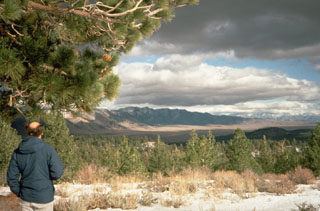Report on Long Valley (United States) — January 1983
Scientific Event Alert Network Bulletin, vol. 8, no. 1 (January 1983)
Managing Editor: Lindsay McClelland.
Long Valley (United States) Seismicity declines; epicentral area deforms
Please cite this report as:
Global Volcanism Program, 1983. Report on Long Valley (United States) (McClelland, L., ed.). Scientific Event Alert Network Bulletin, 8:1. Smithsonian Institution. https://doi.org/10.5479/si.GVP.SEAN198301-323822
Long Valley
United States
37.7°N, 118.87°W; summit elev. 3390 m
All times are local (unless otherwise noted)
"The level of earthquake activity in the caldera continued to abate following the intense swarm that began 6 January. In mid-February, earthquakes of magnitude greater than or equal to 1 have occurred in the caldera at a rate of roughly 30/day, compared to rates of about 100/day toward the end of January and 1,000/day on 7 January. Background activity for several months prior to the January swarm averaged 8-10 earthquakes per day of magnitude greater than or equal to 1 in the caldera. No events with magnitudes greater than 3 have been recorded in Long Valley since the brief flurry that included two M 4 and one M 3.5 earthquakes on 3-4 February.
"In the days immediately following the earthquake activity of 6 January, various deformation networks in the epicentral region were resurveyed. Preliminary analysis of laser-ranging measurements and precise leveling showed that strains of 3-4 ppm and uplift of up to 7 cm accompanied the earthquake activity. The deformation pattern generally resembled that observed since mid-1980, although recently determined changes appeared to be most pronounced in the epicentral region, 2-5 km E of the town of Mammoth Lakes.
"While no definitive statement can be made on the basis of available information, it appears that the deformation pattern can be explained by movement within the source region of the earthquakes. One preliminary model suggests up to 20 cm of right-lateral slip on the seismically defined fault zone, accompanied by 80 cm of opening within that zone. The right slip is consistent with seismically determined focal mechanisms for the earthquakes. Other evidence for extension at depth in the region comes from the re-analysis of the two largest May 1980 earthquakes, which can most simply be explained as the rapid opening of a tensile crack that is filled with fluid as it grows."
Geological Summary. The large 17 x 32 km Long Valley caldera east of the central Sierra Nevada Range formed as a result of the voluminous Bishop Tuff eruption about 760,000 years ago. Resurgent doming in the central part of the caldera occurred shortly afterwards, followed by rhyolitic eruptions from the caldera moat and the eruption of rhyodacite from outer ring fracture vents, ending about 50,000 years ago. During early resurgent doming the caldera was filled with a large lake that left strandlines on the caldera walls and the resurgent dome island; the lake eventually drained through the Owens River Gorge. The caldera remains thermally active, with many hot springs and fumaroles, and has had significant deformation, seismicity, and other unrest in recent years. The late-Pleistocene to Holocene Inyo Craters cut the NW topographic rim of the caldera, and along with Mammoth Mountain on the SW topographic rim, are west of the structural caldera and are chemically and tectonically distinct from the Long Valley magmatic system.
Information Contacts: D. Hill, USGS, Menlo Park, CA.

